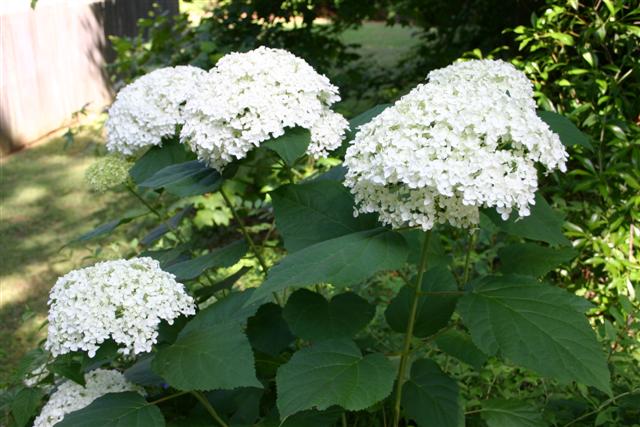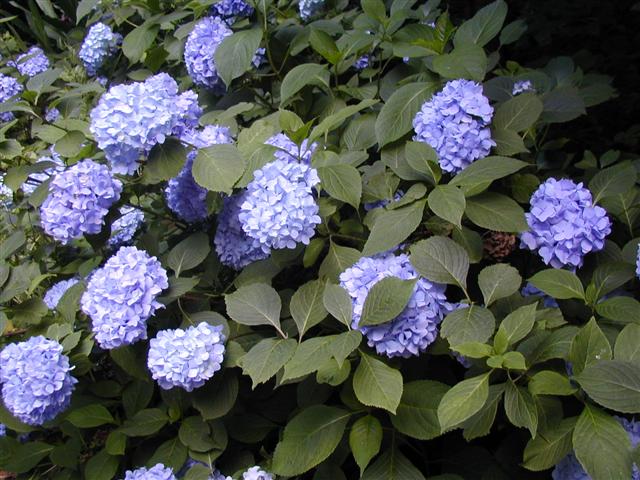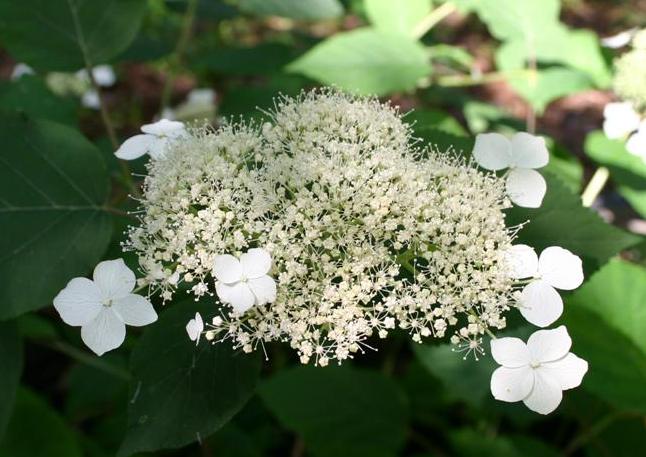Georgia Gardener Newsletter Design Tip: July 9, 2009
Hydrangeas in the Garden

|

|
|
Annabelle Hydrangea
|
Penny Mac Hydrangea
|
Which Hydrangeas Are Right For You
A lot of work has been done over the past several decades to broaden our choices of landscape-worthy hydrangeas. Most
people are familiar with the large mophead and even the lacecap hydrangeas from our mother's and grandmother's gardens.
The majority of these early hydrangeas were cultivars of the French hydrangea. There
are many species of hydrangea and each species has had several (sometimes many) different cultivars. The
most common landscape hydrangeas are cultivars of the French hydrangea (Hydrangea macrophylla), the oakleaf
hydrangea (H. quercifolia), the smooth hydrangea (H. arborescens) and the panicle hydrangea (H. paniculata). The blooms of these hydrangeas look vastly different, bloom times and
colors vary and some are even repeat-bloomers.
While most hydrangeas prefer to grow in morning sun or all-day partial
shade and be planted in rich, well-draining soil, some seem quite tolerant
of full sun and can therefore be used in practically any garden. By selecting
different species and cultivars of hydrangeas for your garden, you can
have blooms from early summer until fall in shade to sun.
A quick note about the structure of hydrangea flowers is in order. Hydrangea flowers are classified into two types: sterile
and fertile. The differences are particularly noticeable on lacecap hydrangeas:

The large showy flowers at the perimeter of the lacecap cluster and also
the predominant flowers of the mophead varieties are the sterile flowers
(actually called florets). They will produce no viable seed but their petals
do attract pollinators. The tiny flowers at the center of the lacecap cluster
and on some of the upright clusters are the fertile flowers. On some plants
they will produce viable seed.
Smooth Hydrangea: Hydrangea arborescens (Georgia native)
This hydrangea commonly found growing wild in low moist forests and along streams
produces white flowers that are either mophead or lacecap beginning in early June.
Smooth hydrangea blooms on new growth and can be pruned during the fall and
winter without removing next year's flowers. Blooming is not harmed by late frosts
making this a great hydrangea for colder climates. Even browsing done by deer in the fall and winter will not keep
this hydrangea from putting on a good show the following summer. Mature size is about 5-6 feet tall and wide. Some
suckering may occur.
Common Cultivars: Annabelle (mophead), Dardom (lacecap), Hills of Snow (lacecap), White Dome (lacecap),
Ryan Gainey (mophead and named for Atlanta gardening guru)
To muddy the waters a bit further, there is a sub-species (sometimes classified as a separate species) of our smooth
hydrangea (H. radiata). This lesser-known plant can be found wild in the Appalachians. It also has white flowers but
the undersides of the leaves are silver. I have grown this plant in metro Atlanta and it has performed well. Of note, it
seemed to need a bit more sun than expected.
Cultivars of this hydrangea include: Hayes Starburst (dome cluster of sterile
florets), Samantha (mophead)
French Hydrangea: Hydrangea macrophylla (old-fashioned mophead)
Once the standard pink or blue mophead hydrangea of the old South, extensive work
has been done on this species of hydrangea producing
numerous cultivars that have a wide range of flower color and style, including mophead and
lacecap. Mature size is about 5-6 feet tall and wide. Dwarf varieties (3-4
feet tall and wide), repeat bloomers and even variegated plants have also
been developed. New varieties are constantly being introduced.
This is the only species of hydrangea where the flower colors can be changed
by altering the pH of the soil. To obtain blue flowers, the soil needs
to be acidic (pH less than 7.0) and is best altered the season before you
want to change flower color. Adding products that contain sulfur (aluminum
sulfate) will acidify the soil. Use about 1-3 tablespoons per gallon of
water annually. To obtain pink flowers, you must have alkaline soil (pH
above 7.0). Once again start a year early. Adding about a cup of lime yearly
will raise the pH as needed. Having neutral soil (pH of 7.0) seems to produce
lavender flowers on some varieties. In clay soils, a complete flower change
may take a few years. In sandy soils, it will happen faster.
Common Cultivars: Nikko Blue (mophead), Dooley (mophead), Blue Wave (Lacecap),
Endless Summer* (repeat blooming mophead), Penny Mac (repeat blooming mophead),
Sister Teresa (white mophead), Lady in Red (pinkish-red lacecap).
*The Endless Summer hydrangea has been expanded into an entire line of repeat-blooming varieties: The Original (mophead),
Blushing Bride (white mophead with semi-double florets), Twist-n-Shout (lacecap).
These hydrangeas should be pruned only if needed right after they finish blooming.
Pruning in the fall or winter will diminish blooming the following year.
Those cultivars that repeat bloom will produce flowers on both old and new growth, but are still
best pruned after the main summer flush.
Similar to the smooth hydrangea, the French hydrangea has been divided with a new species emerging:Hydrangea serrata.
This hydrangea is very similar to the French hydrangea in flower form and color but appears to be a smaller shrub - on the
order of about 3-4 feet tall and wide.
Oakleaf Hydrangea: Hydrangea quercifolia (southern native)
Another native, this large hydrangea produces big upright stalks of white flowers (sterile and fertile) in June and July
that will fade from pink to straw. It's obvious to see how the plant gets its common name by the oak shape of the leaves which
turn a beautiful crimson color in the fall. Older stalks on the plant have lovely peeling bark which lends to great winter
interest.
Oakleaf hydrangea can grow to be quite large and I've seen mature specimens that were nearly 10x10. There are at least three
dwarf cultivars (3-4 feet tall and wide) and some that have been bred to have large flower clusters often with double florets.
The oakleaf hydrangea blooms on old growth and should be pruned only if
needed right after flowering before it sets its flower buds for the following
year. Please note this can be a very narrow window of opportunity. Sometimes
it's best to just remove the faded flowers and only the oldest canes that
have stopped flowering.
Common Cultivars: Alice (large shrub), Snowflake (double florets), Snow Queen, Pee Wee (dwarf), Sykes (dwarf), Little Honey
(dwarf with golden leaves)
Panicle Hydrangea: Hydrangea paniculata
This hydrangea produces large upright stalks or mopheads of white flowers
that will fade from pink to straw. This hydrangea, especially the cultivar
'Tardiva' is the last to bloom and often doesn't get started until August
or later. Like the smooth hydrangea, Hydrangea paniculata blooms on new growth and can be pruned in the fall or winter without
removing next year's flower buds. Late frosts will not damage the flowers making this
another choice for colder climates. Ditto on the deer problem. This hydrangea seems very tolerant of full sun. Mature size
is about 6-8 feet tall and wide. This hydrangea is often sold in tree form.
Common Cultivars: Grandiflora, aka Pee Gee (mophead), Tardiva (upright stalks), Limelight (upright stalks with a hint of green),
Little Lamb (dwarf with upright stalks), Snow Mountain (upright stalks)
For more information on the many varieties of hydrangeas, visit this
website
or the web site of the
American Hydrangea Society.
Copyright © 2009 by Theresa Schrum - All rights reserved
No part of this website may be reproduced without the expressed written permission of Theresa Schrum




